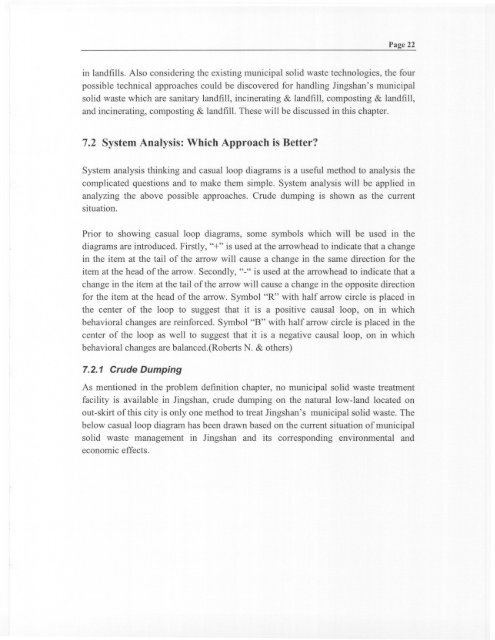a case study of municipal solid waste management in the ... - lumes
a case study of municipal solid waste management in the ... - lumes
a case study of municipal solid waste management in the ... - lumes
Create successful ePaper yourself
Turn your PDF publications into a flip-book with our unique Google optimized e-Paper software.
Page 22<strong>in</strong> landfills. AIso consider<strong>in</strong>g <strong>the</strong> exist<strong>in</strong>g <strong>municipal</strong> <strong>solid</strong> <strong>waste</strong> technologies, <strong>the</strong> fourpossible technical approaches could be discovered for handl<strong>in</strong>g J<strong>in</strong>gshan's <strong>municipal</strong><strong>solid</strong> <strong>waste</strong> which are sanitary landfill, <strong>in</strong>c<strong>in</strong>erat<strong>in</strong>g & landfill, compost<strong>in</strong>g & landfill,and <strong>in</strong>c<strong>in</strong>erat<strong>in</strong>g, compost<strong>in</strong>g & landfill. These will be discussed <strong>in</strong> this chapter.7.2 System Analysis: Which Approach is Better?System analysis th<strong>in</strong>k<strong>in</strong>g and casualloop diagrams is a useful method to analysis <strong>the</strong>complicated questions and to make <strong>the</strong>m simple. System analysis will be applied <strong>in</strong>analyz<strong>in</strong>g <strong>the</strong> above possible approaches. Crude dump<strong>in</strong>g is shown as <strong>the</strong> currentsituation.Prior to show<strong>in</strong>g casual loop diagrams, same symbols which will be used <strong>in</strong> <strong>the</strong>diagrams are <strong>in</strong>troduced. Firstly, "+" is used at <strong>the</strong> arrowhead to <strong>in</strong>dicate that a change<strong>in</strong> <strong>the</strong> item at <strong>the</strong> tail <strong>of</strong> <strong>the</strong> arrow will cause a change <strong>in</strong> <strong>the</strong> same direction for <strong>the</strong>item at <strong>the</strong> head <strong>of</strong> <strong>the</strong> arrow. Secondly, "-" is used at <strong>the</strong> arrowhead to <strong>in</strong>dicate that achange <strong>in</strong> <strong>the</strong> item at <strong>the</strong> tail <strong>of</strong> <strong>the</strong> arrow will cause a change <strong>in</strong> <strong>the</strong> opposite directionfor <strong>the</strong> item at <strong>the</strong> head <strong>of</strong> <strong>the</strong> arrow. Symbol "R" with half arrow circle is placed <strong>in</strong><strong>the</strong> center <strong>of</strong> <strong>the</strong> loop to suggest that it is a positive causal loop, on <strong>in</strong> whichbehavioral changes are re<strong>in</strong>forced. Symbol "B" with half arrow circle is placed <strong>in</strong> <strong>the</strong>center <strong>of</strong> <strong>the</strong> loop as well to suggest that it is a negative causal loop, on <strong>in</strong> whichbehavioral changes are balanced.(Roberts N. & o<strong>the</strong>rs)7.2.1 Crude Dump<strong>in</strong>gAs mentioned <strong>in</strong> <strong>the</strong> problem def<strong>in</strong>ition chapter, no <strong>municipal</strong> <strong>solid</strong> <strong>waste</strong> treatmentfacility is available <strong>in</strong> J<strong>in</strong>gshan, crude dump<strong>in</strong>g on <strong>the</strong> naturallow-Iand located onout-skirt <strong>of</strong> this city is only Ollemethod to treat J<strong>in</strong>gshan's <strong>municipal</strong> <strong>solid</strong> <strong>waste</strong>. Thebelow casualloop diagram has been drawn based on <strong>the</strong> current situation <strong>of</strong> <strong>municipal</strong><strong>solid</strong> <strong>waste</strong> <strong>management</strong> <strong>in</strong> J<strong>in</strong>gshan and its correspond<strong>in</strong>g environmental andeconomic effects.
















